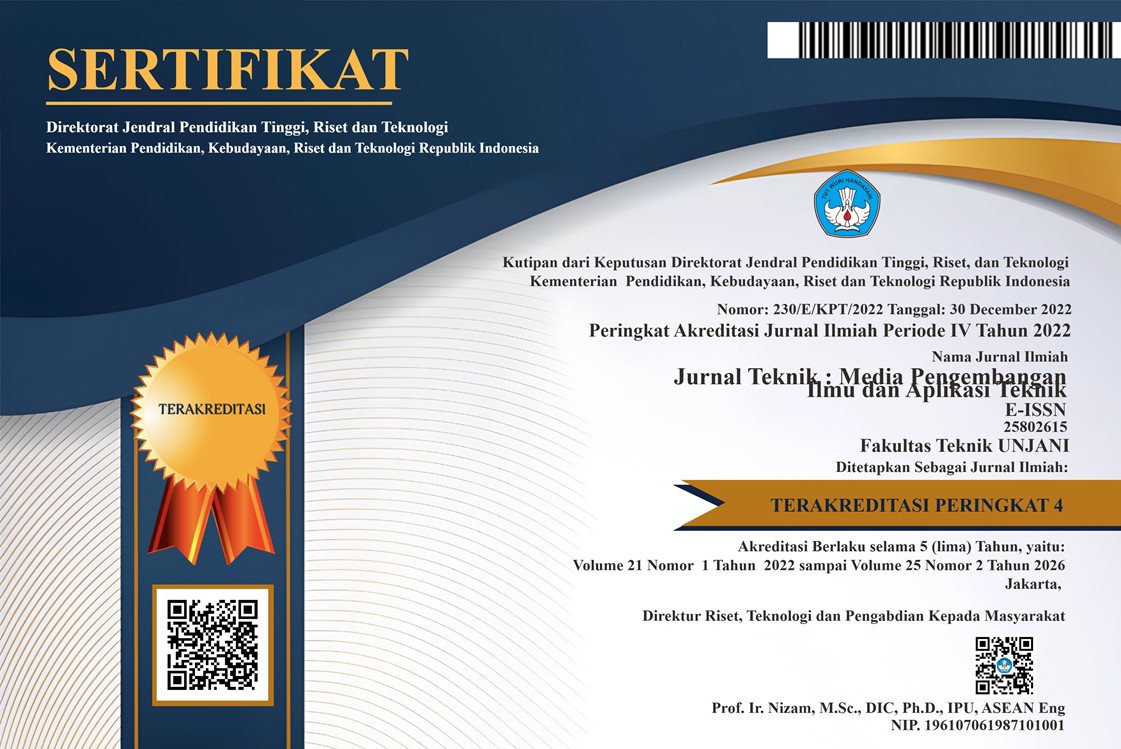A Review: Reliability Assessment of Isolated Phase Busduct Through FMEA and RCFA Methodologies
DOI:
https://doi.org/10.55893/jt.vol24no1.737Keywords:
Failure Mode and Effect Analysis, Isolated Phase Busduct, Risk Priority Number, Root Cause Failure AnalysisAbstract
This research discuss the reliability of the Isolated Phase Busduct (IPB) geothermal generating unit still needs to be improved because the same disturbances still occur, where in the 2018-2023 period these disturbances have contributed to a Loss Production Opportunity of around 65 billion rupiah. Therefore, this research will provide suggestions or suggestions for what factors need to be improved so that the reliability of IPB in each geothermal power plant unit increases. The methods used in this research are failure mode and effect analysis (FMEA) and the Root Cause Failure Analysis (RCFA) method, where FMEA helps in identifying potential failures and determining mitigation priorities and determining the value of the Risk Priority Number (RPN), Root Cause Failure Analysis (RCFA) reveals the main causes of failures that have occurred, from these two methods it is known that the disturbances that occur can actually be identified earlier by 91.2% as well as factors such as manufacture design, aging equipment, improper installation, Lack of Quality Control, and inappropriate mobilization must be eliminated in an effort to increase IPB's reliability where these factors must be considered from the project phase to the operational phase.
References
Al Marzooqi, F. A., Hussain, M., & Ahmad, S. Z. (2019). Performance of physical asset management using the analytic hierarchy process. Property Management, 37(3), 327–345. https://doi.org/10.1108/PM-07-2018-0039
Alsyouf, I., Alsuwaidi, M., Hamdan, S., & Shamsuzzaman, M. (2021). Impact of ISO 55000 on organisational performance: evidence from certified UAE firms. Total Quality Management and Business Excellence, 32(1–2), 134–152. https://doi.org/10.1080/14783363.2018.1537750
Dolin, A. P. (2020). Diagnostic Examination of Isolated Bus Ducts. Power Technology and Engineering, 54(3), 444–449. https://doi.org/10.1007/S10749-020-01230-X/METRICS
Eyuboglu, O. H., Dindar, B., & Gul, O. (2020). Risk Assessment by Using Failure Modes and Effects Analysis (FMEA) Based on Power Transformer Aging for Maintenance and Replacement Decision. Proceedings - 2020 IEEE 2nd Global Power, Energy and Communication Conference, GPECOM 2020, 251–255. https://doi.org/10.1109/GPECOM49333.2020.9247887
Fu, J., Yang, B., Wang, X., Feng, A., Cai, F., & Zhang, H. (2024). Mechanism Analysis of Insulator Fault in Enclosed Isolated Phase Bus Caused by Vibration. The Proceedings of 2023 4th International Symposium on Insulation and Discharge Computation for Power Equipment (IDCOMPU2023), 1101, 349–355. https://doi.org/10.1007/978-981-99-7401-6_34
Hajiagha, S. H. R., Hashemi, S. S., Mohammadi, Y., & Zavadskas, E. K. (2016). Fuzzy belief structure based VIKOR method: An application for ranking delay causes of Tehran metro system by FMEA criteria. Transport, 31(1), 108–118. https://doi.org/10.3846/16484142.2016.1133454
Hatala, M. H., Sukarsono, B. P., & Nukertamanda, D. (2023). Risk and Reliability Improvement Analysis of Boiler System Using the Failure Mode Effect Analysis & Critical Analysis (FMECA) Method. Spektrum Industri, 21(1), 8. https://doi.org/10.12928/SI.V21I1.98
Kamble, S. N., & Rajiv, B. (2022). Critical Analysis of Machine Condition Monitoring by Using Risk Priority Number and Analytical Hierarchy Process. Journal of Failure Analysis and Prevention, 22(2), 623–632. https://doi.org/10.1007/S11668-022-01350-8/METRICS
Kim, K. O., & Zuo, M. J. (2018). Optimal allocation of reliability improvement target based on the failure risk and improvement cost. Reliability Engineering & System Safety, 180, 104–110. https://doi.org/10.1016/j.ress.2018.06.024
Li, Y., Sun, P., Li, H., Qu, L., Gong, J., & Huang, S. (2024). Coordinated Control of Intentional Islanding and Phase Sequence Exchange for Enhancing Transient Stability of Isolated Power Grid. IEEE Transactions on Industrial Electronics, 71(5), 5205–5214. https://doi.org/10.1109/TIE.2023.3285993
Lu, P., Powrie, H. E., Wood, R. J. K., Harvey, T. J., & Harris, N. R. (2021). Early wear detection and its significance for condition monitoring. Tribology International, 159, 106946. https://doi.org/10.1016/j.triboint.2021.106946
Maletic, D., Maletic, M., Al-Najjar, B., & Gomiscek, B. (2020). An Analysis of Physical Asset Management Core Practices and Their Influence on Operational Performance. Sustainability 2020, Vol. 12, Page 9097, 12(21), 9097. https://doi.org/10.3390/SU12219097
Mzougui, I., & El Felsoufi, Z. (2019). Proposition of a modified FMEA to improve reliability of product. Procedia CIRP, 84, 1003–1009. https://doi.org/10.1016/j.procir.2019.04.315
Patil, S. S., & Bewoor, A. K. (2021). Reliability analysis of a steam boiler system by expert judgment method and best-fit failure model method: a new approach. International Journal of Quality and Reliability Management, 38(1), 389–409. https://doi.org/10.1108/IJQRM-01-2020-0023
Patil, S. S., Bewoor, A. K., & Patil, R. B. (2021). Availability analysis of a steam boiler in textile process industries using failure and repair data: A case study. ASCE-ASME Journal of Risk and Uncertainty in Engineering Systems, Part B: Mechanical Engineering, 7(2). https://doi.org/10.1115/1.4049007
Patil, S. S., Bewoor, A. K., Patil, R. B., Kumar, R., Ongar, B., Sarsenbayev, Y., PraveenKumar, S., Ibrahim, A. M. M., Alsoufi, M. S., & Elsheikh, A. (2022). A New Approach for Failure Modes, Effects, and Criticality Analysis Using ExJ-PSI Model—A Case Study on Boiler System. Applied Sciences 2022, 12(22), 11419. https://doi.org/10.3390/APP122211419
Petrescu, L., Petrescu, M. C., Cazacu, E., & Ionita, V. (2021). Risk Priority Number vs Action Priority in Electrical Systems. 12th International Symposium on Advanced Topics in Electrical Engineering, ATEE 2021, 1–6. https://doi.org/10.1109/ATEE52255.2021.9425178
Sheng, F. L., Thin Wei, C., Teng, T. L., & Chik Hooi, L. (2023). Recovered Scan Failure Investigation and Failure Mechanism Determination. Proceedings of the International Symposium on the Physical and Failure Analysis of Integrated Circuits, IPFA, 2023-July, 1–6. https://doi.org/10.1109/IPFA58228.2023.10249095
Siva Sathyanarayana, M., & Amarnath, J. (2012). Modelling and Analysis of Trajectories of A Wire Like Particle in A Three Phase Common Enclosure Gas Insulated Busduct (GIB) With Image Charges. International Journal of Engineering and Advanced Technology (IJEAT), 1(5), 2249–8958. www.ijeat.org
Wang, H., Zhao, Z., Dai, Z., Peng, Z., & Li, S. (2021). Using Data Mining and Root Cause Analysis Method for Failure Analysis in Electronic Components. IOP Conference Series: Materials Science and Engineering, 1043(2), 1–9. https://doi.org/10.1088/1757-899X/1043/2/022024
Additional Files
Published
Issue
Section
License
Copyright (c) 2025 Handoko Rusiana Iskandar, Ahmad Daelami, Awang Rahmawan Prakoso, Cepi Arifin, Miftah Farid

This work is licensed under a Creative Commons Attribution-NonCommercial-ShareAlike 4.0 International License.
Penulis yang menyerahkan artikel di Jurnal Teknik: Media Pengembangan dan Aplikasi Teknik untuk keperluan publikasi telah mengetahui bahwa Jurnal Teknik: Media Pengembangan dan Aplikasi Teknik memberikan akses terbuka terhadap konten untuk mendukung pertukaran informasi mengenai ilmu pengetahuan, sesuai dengan penerbitan daring yang berbasis Open Access Journal dan mengikuti Creative Commons Attribution 4.0 International License. Sehingga penulis setuju dengan ketentuan-ketentuan berikut:
1. Penulis memegang hak cipta dan memberikan hak publikasi pertama kepada pihak jurnal dengan pekerjaan secara bersamaan
di bawah Creative Commons Attribution 4.0 International License yang memungkinkan orang lain untuk berbagi pekerjaan
dengan pengakuan kepengarangan karya dan publikasi pertama artikel tersebut di Jurnal Teknik: Media Pengembangan dan
Aplikasi Teknik.
2. Penulis dapat melakukan perjanjian tambahan untuk hak distribusi non-eksklusif artikel yang telah diterbitkan di jurnal ini
(misalnya, posting ke sebuah repositori institusi atau menerbitkannya dalam sebuah buku), dengan mengakui bahwa
publikasi pertama dilakukan di Jurnal Teknik: Media Pengembangan dan Aplikasi Teknik.
3. Penulis diizinkan dan didorong untuk menyebarkan karya mereka secara daring (misalnya, dalam repositori institusi atau
laman web penulis) setelah artikel terbit (proses penerbitan artikel selesai). Hal ini terkait dengan imbas dari pertukaran
informasi yang produktif (Lihat Pengaruh Open Access).












